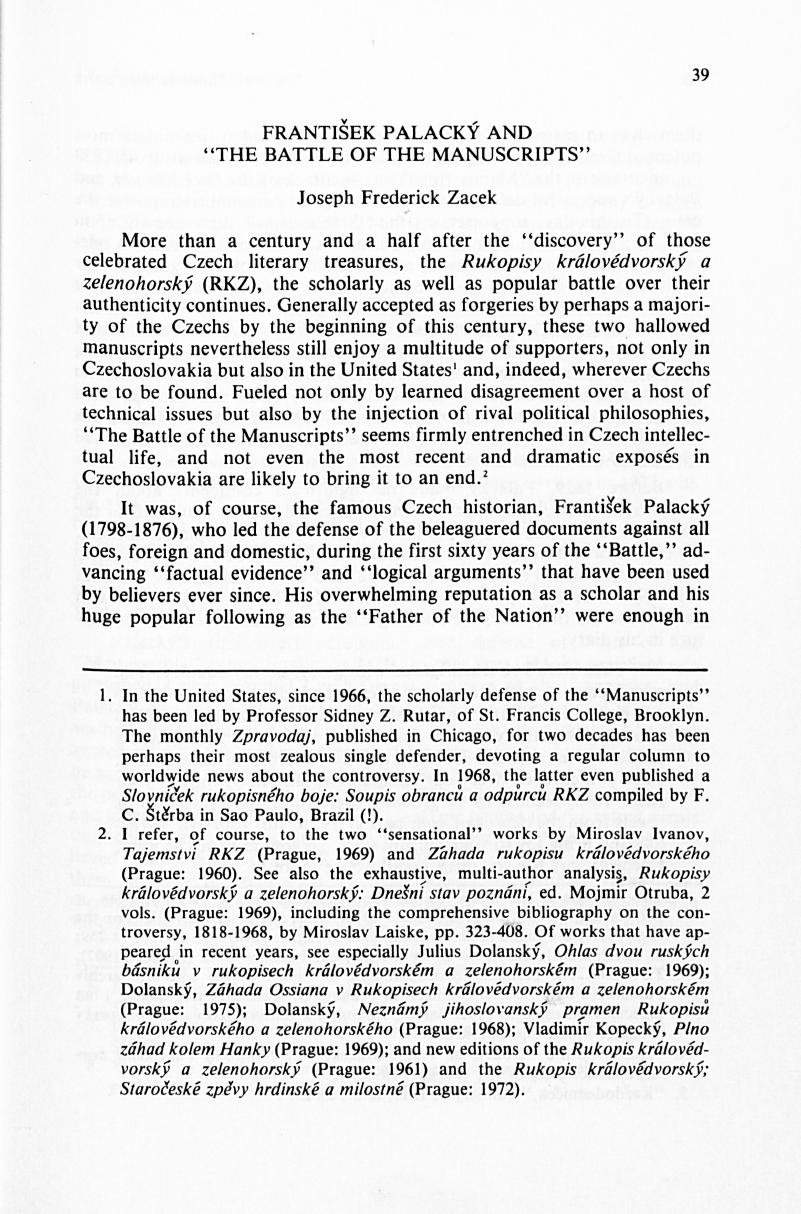No CrossRef data available.
Published online by Cambridge University Press: 20 November 2018

1. In the United States, since 1966, the scholarly defense of the “Manuscripts” has been led by Professor Sidney Z. Rutar, of St. Francis College, Brooklyn. The monthly Zpravodaj, published in Chicago, for two decades has been perhaps their most zealous single defender, devoting a regular column to worldwide news about the controversy. In 1968, the latter even published a Slovníček rukopisného boje: Soupis obranců a odpůrců RKZ compiled by F. C. Štůrba in Sao Paulo, Brazil (!).Google Scholar
2. I refer, of course, to the two “sensational” works by Miroslav Ivanov, Tajemství RKZ (Prague, 1969) and Záhada rukopisu královédvorského (Prague: 1960). See also the exhaustive, multi-author analysis, Rukopisy královédvorský a zelenohorský: Dnešní stav poznání, ed. Mojmir Otruba, 2 vols. (Prague: 1969), including the comprehensive bibliography on the controversy, 1818-1968, by Miroslav Laiske, pp. 323-408. Of works that have appeared in recent years, see especially Julius Dolanský, Ohlas dvou ruských básniků v rukopisech královédvorském a zelenohorském (Prague: 1969); Dolanský, Záhada Ossiana v Rukopisech královédvorském a zelenohorském (Prague: 1975); Dolanský, Neznámý jihoslovanský pramen Rukopisů královédvorského a zelenohorského (Prague: 1968); Vladimír Kopecký, Plno záhad kolem Hanky (Prague: 1969); and new editions of the Rukopis královédvorský a zelenohorský (Prague: 1961) and the Rukopis královédvorský; Staročeské zpěvy hrdinské a milostné (Prague: 1972).Google Scholar
3. This struggle is the theme of my monograph, Palacký: The Historian as Scholar and Nationalist (The Hague: 1970). Most of Palacký's writings on the controversy are found in his Gedenkblätter (Prague: 1874), pp. 67-77, 214-259; in Czech translation in his Spisy drobné, ed. Leander Čech (Prague: 1902), 3:547-590. His pertinent correspondence is chiefly in the Literární archiv Památníku národního písemnictví in Prague. Of secondary treatments, I am especially indebted to F.M. Bartoš, Rukopisy královédvorský a zelenohorský (Prague: 1946), esp. pp. 46-85.Google Scholar
4. “Autobiografie” (1823), in V.J. Nováček, ed., Františka Palackého korrespondence a zápisky, 1 (Prague: 1898), 18.Google Scholar
5. “Každodenniček,” January 1, 1819, ibid., 28-29.Google Scholar
6. In his Gedenkblätter, pp. 19-47; reprinted in Czech translation in SD, 3:489-509.Google Scholar
7. In a parallel German-Czech version prepared by Oldřich Králík and Jiří Skalička (Ostrava: 1968).Google Scholar
8. Vol. 48, pp. 136-169; excerpts were reprinted, with later excisions, in Gedenk., pp. 67-77, and in Czech translation in SD, 3:549-557.Google Scholar
9. Wiener Jahrbücher, 48:166. At this point Kopitar, a pupil and disciple of Dobrovský, added a footnote in which he defended the validity of Dobrovský's arguments.Google Scholar
10. “Časopisové čeští r. 1834,” ČČM 8(1834), 462-468.Google Scholar
11. In Die ältesten Denkmäler der böhmischen Sprache (see below), pp. 174-175. Palacký‘s account of how he reached his decision about the RZ is more dramatic and revealing: determined to use his newly-gained takt and unwilling simply to accept Dobrovský‘s negative verdict, “the author [Palacký] went to the Museum and had it [the manuscript of the RZ] produced for his inspection. After a few minutes of the autopsy, he was perfectly convinced and forever decided: he had no further doubts about the complete authenticity of the fragment. That same day, when the author revealed his new conviction to his friend, Šafařík, the latter replied that he had never had any doubts about it. Already at that time we agreed upon the plan for the present study.”Google Scholar
12. Summarized in Czech in SD, 3:547-549.Google Scholar
13. November 5, 6, 10, 1858: they were reprinted in Gedenk., pp. 214-231, and in SD, 3:557-569.Google Scholar
14. Vol. 1, Part 1, pp. 127-152, 575 ff.Google Scholar
15. Vol. 1, Part 3, pp. 87-111: “Die altböhmischen Handschriften und ihre Kritik.” Reprinted in Gedenk., pp. 231-259; and in SD, 3:569-590.Google Scholar
16. Büdinger's reply (HZ, pp. 112-117), in which he charged that Palacký had regularly misquoted him and rhetorically dodged the real issues, was not even noticed by Palacký until 1874. Jaroslav Goll characterized Palacký uncharitably but accurately: “Palacký was a man of firm convictions and strong will. He did not change much…. Whatever he decided, in that he persisted…. His favorite word was ‘unyielding’ (neoblomný). He carried on a discussion or a debate … as long as he could expect others to submit, but he stopped when he himself would have to yield, and rather took no further part in the matter.” ČČH 4:253-254.Google Scholar
17. Pp. 192-3.Google Scholar
18. See the copious correspondence in 1859, in the Literární Archív Památníku Národního Písemnictvi in Prague, of Palacký with Šembera (sign. II C II, II B 8) and with Gindely (II A 3).Google Scholar
19. Palacký to Šembera, March 26, 1859, LAPNP, Palacký collection, sign. II C II.Google Scholar
20. P. 75.Google Scholar